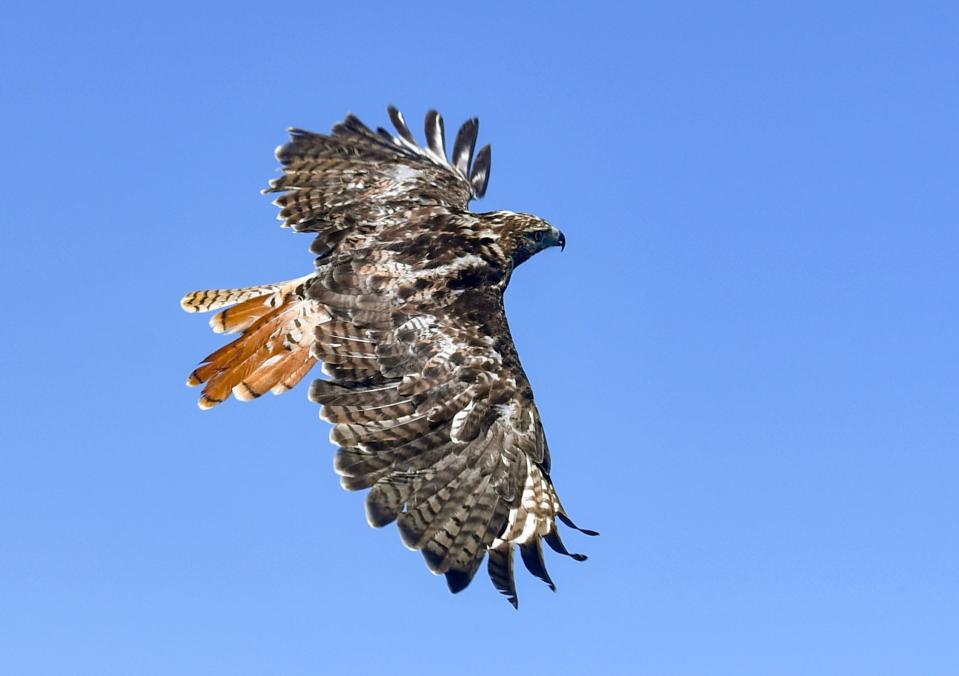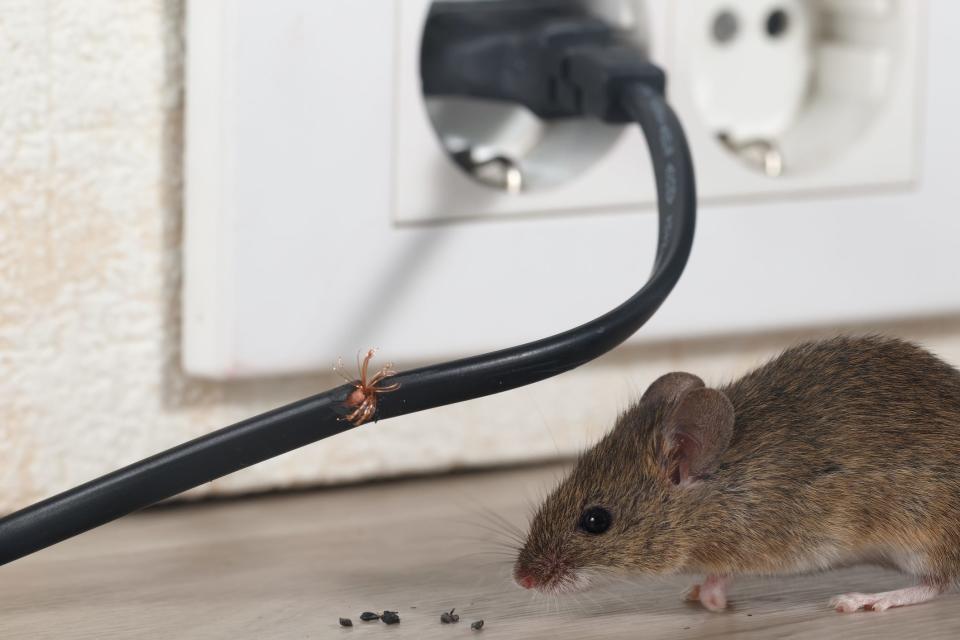Got mice? Your pest control measures might kill birds of prey in your neighborhood, too.
Every autumn at my house is also, secretly, called “mice-murdering season” when we do battle with families of pesky, albeit cute, white-footed mice trying to take up residence for the winter. Some years we only have a few, but other years it’s a major incursion. Our well-fed cats can’t be bothered to defend hearth and home, leaving their human co-inhabitants to resort to more drastic measures.
During the fall of 2021 our neck of the woods experienced what is referred to as a “heavy mast year” due to an abundance of acorns and nuts (mast) from our deciduous oak and hickory trees. A rodent population “bloom” is expected the year following heavy mast due to the wealth of food, resulting in healthy females and larger litters of pups. Right on schedule, this fall we are experiencing more mice moving inside than in recent years. The clash between Homo sapiens and Peromyscus leucopus has begun.

For the past several years we have used plastic snap traps for eliminating mice. We bait them with peanut butter, and I have found them easier to use compared to the old wood-style with metal snap hinge. A few weeks ago, we found mouse droppings on the kitchen floor and set five traps. Within a few days we gained the upper hand in the white-footed mouse battle with more than a dozen trapped. I disposed the vanquished mice at the edge of the back field for any number of wild animals to partake of a free snack.
St. James School charity event'He’d be so happy.' Danielson Thanksgiving food giveaway lives on without beloved pastor
I learned from Mary-Beth Kaeser at Horizon Wings Raptor Rehabilitation in Ashford about the dangers that rat poison, or rodenticides, pose to raptors and other animals due to “secondary” poisoning. Simply put, although the poisons are designed for killing rodents, the raptors and other animals who eat poisoned rodents can be harmed or killed by secondary poisoning, known as relay toxicosis. I contacted Mary-Beth recently about her experience treating raptors poisoned by ingesting rodenticides and here is her response.
“Tufts University has been doing a study on this for many years. Specifically, Dr. Maureen Murray. Her study in 2011 showed 88 percent of the birds they tested have rodenticide in them, at a level high enough to treat. In 2020 she did another study of 65 red tail hawks admitted to the clinic. Every single one of them had rodenticide in their systems. I dealt with four birds poisoned in the span of a month this year. One never made it here but had all the classic symptoms, and the woman had just put rodenticide out earlier that week. The three other birds were in areas where people admitted to having rodenticide. Every single one of those birds died despite treatment within the first 12 hours they were here. Every single one of them had blood in their mouth and nose but no traumatic injuries and were not hit by cars.”
Giving TuesdayGiving Tuesday is Nov. 29. Here are 10 nonprofits in your backyard.

What are the three types of rodenticide?
I learned more about this issue from a recent article by Anna Morris, environmental educator at Vermont Institute of Natural Science, published by Northern Woodlands in their Outside Story newsletter. Here are a few key points from her column. It can be found at: https://northernwoodlands.org/outside_story/article/rodenticides
There are three types of rodenticides: first generation anticoagulants, second generation anticoagulants and non-anticoagulants. Anticoagulants work by blocking blood clotting and cause fatal internal bleeding. First generation means they were developed decades ago and require the rodent to feed on the poison multiple times. Second generation are more toxic and kill with a single dose. Neither version is instantaneous, making a sick and dying rodent easy prey to a raptor. Even after death the poison remains in the liver of the dead rodent, increasing the risk of relay toxicosis for birds of prey.
Killingly, CT law enforcementKillingly wants a local police force someday. This $630K building could be the next step.
The risk of secondary poisoning from non-coagulant rodenticides has not been studied thoroughly. While they are believed to pose a low risk to birds, they have not been proven to pose no risk. Morris writes, “If you’re looking for a rodenticide that will target only mice and leave owls completely alone, there is currently no such miracle. All chemicals on the market to kill rodents are also toxic to birds to some degree.”
To learn more about what is happening with rodenticide poisoning of our raptor birds, I checked the Horizon Wings Facebook page and found a repost from another raptor rehabilitation center, A Place Called Hope in Killingworth. I learned the U.S. Environmental Protection Agency now prohibits everyday consumers from purchasing second generation “single dose” anticoagulant rodenticides, but it is allowed in quantities of 8-pound minimums for pest control companies. The problem persists and A Place Called Hope reports, “Every single bird we have sent out to be tested for anticoagulant rodenticides results positive for Brodifacoum, one of the ingredients for second generation anticoagulant rodenticides.”
Norwich hockeyWhy are Norwich residents humming the Canadian national anthem? Meet the city's new team.
“Second generation anticoagulant rodenticides are the top choice for pest management companies because the results are fatal. Problem is the results are fatal to all that ingest it. As fatal as it is, it does not solve the problem unless continuously applied which means it continuously affects more than rats or mice, killing more and more non-targeted victims.”

What can you do to stop birds from being poisoned?
When it comes to managing rodents, it is important to consider various options before going with poisons that don’t effectively target the intended animal. One suggestion is to read up on integrated pest management strategies. Information can be found at the U.S. Environment Protection Agency website: https://www.epa.gov/safepestcontrol/integrated-pest-management-ipm-principles
A Place Called Hope and Horizon Wings also suggest that if the issue of rodenticides tragically killing raptor birds is important to you, please consider writing to your legislators to ask them to have second generation anticoagulants rodenticides banned in the state. If they continue to be used, we’ll continue to see sick and dying raptors admitted to raptor rehabilitation facilities.
Norwich roundaboutsIt's official: CTDOT withdrew Rte. 82 plan. That doesn't mean there won't be roundabouts.
There is nothing quite like seeing a soaring bald eagle or hearing the haunting call of a screech owl. While the population of our raptors like bald eagles has increased in the past few decades, they are still faced with human-created challenges. I hope you’ll join me in learning more about these challenges and finding ways that we can do our part to ensure the long-term survival of these precious animals.
We live in a beautiful place called The Last Green Valley National Heritage Corridor, home to many amazing creatures. I hope you’ll join me and together let us care for it, enjoy it and pass it on.
Bill Reid is the chief ranger of The Last Green Valley National Heritage Corridor and can be reached at 860-774-3300 or by email at bill@tlgv.org.
This article originally appeared on The Bulletin: How to get rid of mice without killing local hawks, owls

